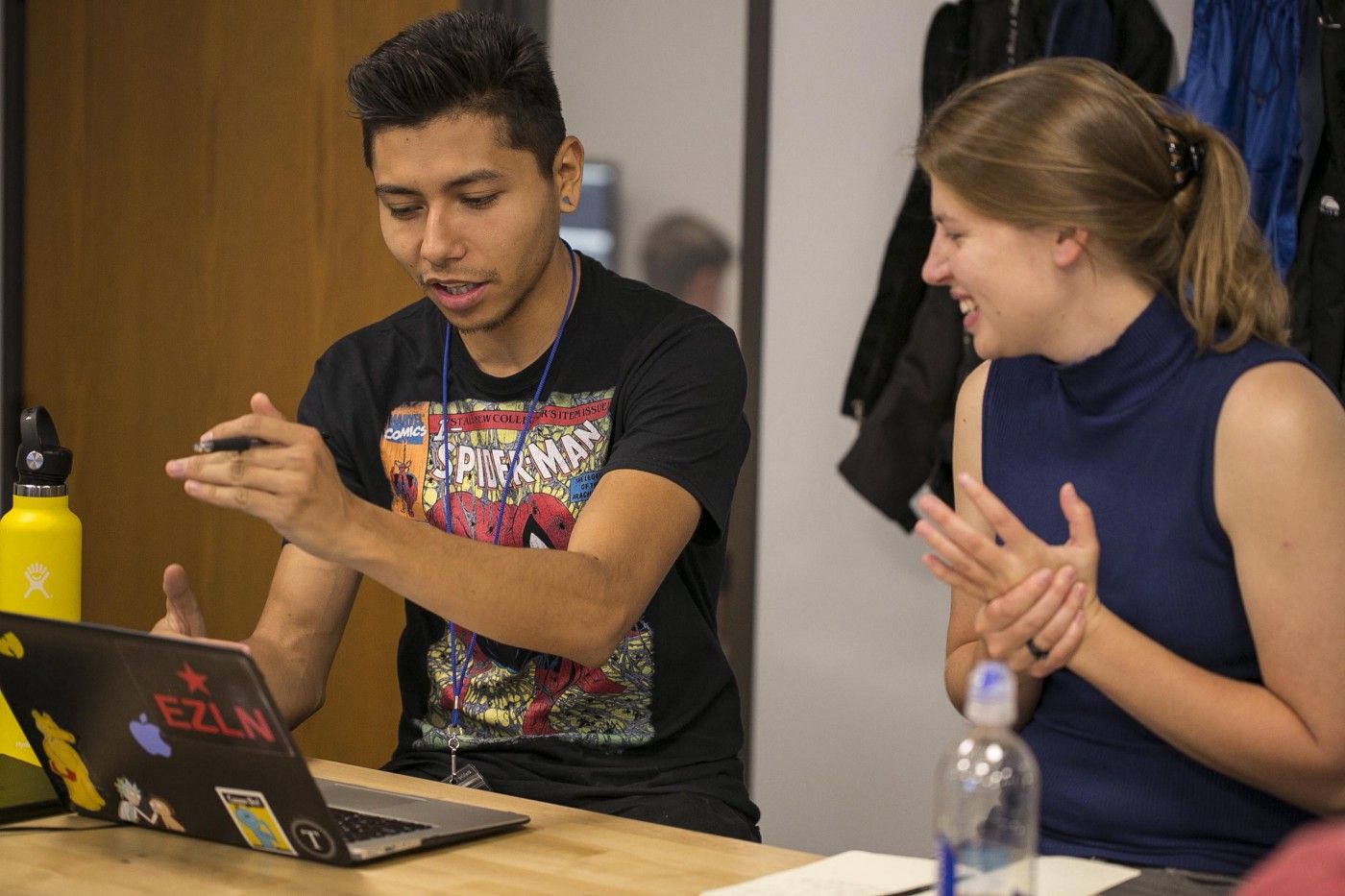4 Steps to Answer Student Questions with Zest
A Turing instructor shares his quest to create a classroom where every student thrives.

My quest to curate a classroom where students thrive
I remember the first time I witnessed the art of answering a student’s technical question. This was done with a combination of grace, empathy, and technical prowess that left me both stunned and excited. I was immediately swept up in the level of detail, compassion, and enthusiasm that Rachel Warbelow was able to encompass with a few intentional sentences.
We were in an in-person setting at Turing School of Software & Design at one of our Try Coding weekends. Try Coding is an introductory course that Turing offers to people with zero programming experience. These humans are at their most vulnerable and diffident states as they decide whether or not Turing is the place best equipped to help them switch careers and dive into the world of web development.
I was helping out as a teaching assistant without much experience as a leader in classroom settings. It was November 2018. Rachel was able to illuminate the classroom with a smile and a few nods as the student began asking their question.
“Why does the loop run 10 times even though it looks like it stops at 9?” asked the student.
The first words out of Rachel’s mouth back to the student were words of encouragement.
“That’s an excellent question,” said Rachel, which indicates that this classroom is a safe space that encourages students to lean into their curiosity.
Then, Rachel repeated the question back to the student to show that she was actively listening to the nuance of the student’s question. Next, she was able to clearly and slowly answer the student’s question avoiding words like “just”, “simple”, or “easy,” and in a way that allowed her passion for the subject matter to shine and shimmer with each word.
“In programming, we start counting at 0, so the loop runs 10 times, but the final number we see the counter increment to is 9, because we began at 0, then 1, then 2, and so on.”
The final piece of her delivery was a follow-up question that probed the student’s level of understanding after her answer had been delivered.
“Did that answer your question?” — pauses for confirmation from the student — “Any other questions coming up on this topic?”
This follow-up creates space not only for the student who first asked the question, but it also encourages the class to remain inquisitive as the conversation moves forward.
Answering student questions in any group or classroom environment will either create an inviting and shared space for more questions, or our answers will cause the space and the students to both contract and recoil from their curiosity for fear of ridicule or shame. For this reason, we educators must put forth conscious effort towards creating a space that fosters student engagement.
We can achieve this end by approaching questions within a framework that balances purpose, stimulation, and safety.
As someone who had the privilege to learn close up from one of the best to do it — Rachel Warbelow — I’ve developed a framework for cultivating student wellbeing and inquisitiveness based on my experience, failures, and attention to detail as an instructor at Turing.

1. Safety First
Never interrupt a student before they are finished asking their question. Never.
- This will break the student’s trust
- It will reveal a lack of active listening skills
- It will discourage further questions
- It will encourage and validate peers talking over one another
As a white man, I hold a certain amount of privilege and power, rooted and backed with systems of power within our society that continue to overvalue my whiteness and my maleness. This, mixed with the power of traditional student teacher dynamics within Western education, creates a lopsided and intimidating environment on day one of my classes that I must work to dismantle every time we step into the classroom.
Students who have been traditionally marginalized in both educational settings and society at large must be protected, encouraged, and supported both in the classroom and within the educational institution at large. This includes identity markers such as Black, Indigenous, People of Color, Women, and LGBTTQQIAAP, to name a few.
If I’m not hearing from students with these markers by default, which could be a result of the systemic oppression, injustice, and marginalization they have experienced day in and day out within American society, or the result of my own implicit bias permeating through the classroom, then I need to work to create space and safety for these students in my classroom.
I must work to overcome my own biases that result in racist, sexist, or generally prejudiced behavior.
I must encourage these students to use their voice.
I must validate the worth and belonging of these students within all settings when they speak up.
And, if I see microaggressions take place in my classroom between students, then I need to act as an ally and interrupt the agent committing the microaggression. Furthermore, if I myself am the agent committing a microaggression against a student, then I need to make it clear to the target, that regardless of my intent, that I was wrong. I need to validate their lived experience, and then work to do better. In either situation, I need to follow-up with the target individually to ensure that they know they are supported.
All students should know explicitly and upfront that the space they are in is a safe space for them to advocate for their own learning and engage in discussion as an equal of both their peers and their instructor. Without safety, curiosity and expression will be stifled.
We can’t answer questions with zest if our students do not feel safe enough to ask us their questions.
2. Lift and Legitimize
Asking a question aloud in front of a room full of strangers or peers takes bravery.
We educators need to provide affirmation that we will always have the back of the student that exhibits the courage to ask, clarify, and advocate for their own learning.
We should do this with a few words of encouragement once the student has finished asking their question:
- “Thank you for asking that question!…”
- “This question helps me realize that I brushed over a critical learning point! I appreciate you bringing this to my attention…”
- “Great question!…”
- “I’m so happy to hear from you!…”
- “Yes! Thank you! This leads me to my next point…”
- “I’m excited that you’re starting to investigate the material from that perspective!…”
Questions provide the checkpoints we educators need in order to gauge how well the students are grappling with the material. Questions should be celebrated as insights into where student understanding is or isn’t taking place.
We should always lead with gratitude for the student who is checking in with us and providing these valuable inquiries.

3. I Don’t Know
"I don’t know" is a valid response to a student’s technical question.
This might seem self-explanatory and obvious, or it may strike fear into your soul. Instructors will generally feel an inherent responsibility to know the material that they are covering front to back without any gaps.
Let that go.
Some of the most valuable moments in my classroom begin with me stating that I do not know the answer to a student question.
Then, I’m able to demonstrate the strong processes I’ve developed for obtaining the information that I need to answer technical questions. Students will feel empowered when they see that their instructor isn’t some sort of developer savant and indeed needs to look information up via documentation or StackOverflow the same way that they do — and quite often.
In fact, I will argue that this process of obtaining information related to a specific problem or error and then applying it rapidly is the skill that separates senior and junior developers.
When we provide the space to not only show this research skill in action, but encourage it as part of the learning and development process, then we are pushing our students towards embracing and advancing their own process for dealing with I don’t know.
4. Feedback — Seek It
This idea has 2 legs.
- Repeating the student’s question back to the student, asking a student to repeat their question, or asking for clarification when the question is unclear:
- Students will not always be able to formulate and articulate their thoughts when the material is unclear to them.
- We need to know which topics or ideas are causing the confusion before we can properly address them.
- We always want students to know we’re actively listening to their questions.
2. After answering a question, follow-up with the student to gauge the understanding of both the student and the class at large based on the answer provided. Sometimes the student will provide immediate feedback, but if they don’t, then solicit it.
- “Did that fully answer your question?”
- “Are there other questions related to this topic that are coming up?”
- Did our answer provide enough information for the student’s to synthesize the information? How would we know if we don’t follow up and receive feedback?
- Intentionally create the space for students to voice follow-up questions.
We aren’t serving student needs by thoroughly answering their questions unless we have ample feedback that says that that is indeed what we are doing.
Final Thoughts
I am actively working to remember to slow down, ensure safety, interrupt microaggressions, call out courage in my students, and seek feedback each and every day I have the privilege to teach a class. As educators, we likely won’t always get this right.
I certainly do not.
Still, expanding our awareness with regards to how we answer questions will lead to a more inclusive and rousing classroom, whether remote or in person. It’s one of the ways that we can be intentional in our efforts to foster a healthy and productive learning environment, for all.
The idea, above all, is growth. Growing in the ways we answer student questions with a focus on catalyzing growth in our students’ courage, learning, and level of engagement. If we’re providing more and more zest in our answers to student questions, then we can expect accelerated growth from students in all the areas we hope to see them thrive.
This post was originally shared on Medium.
Tim Tyrrell is an instructor at Turing School. He sees the intersection of education and technology as the most effective means of lifting students up into fulfilling and impactful careers in today's tech industry.

